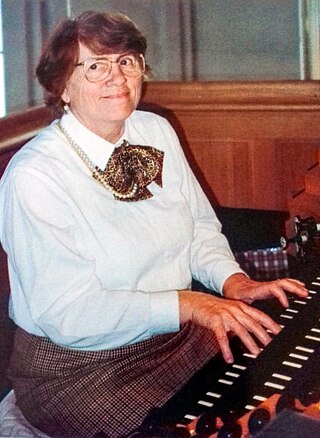
François-HenriClicquot was a French organ builder and was the grandson of Robert Clicquot and son of Louis-Alexandre Cliquot, who were also noted organ builders.

The Church of Saint-Sulpice is a Roman Catholic church in Paris, France, on the east side of Place Saint-Sulpice, in the Latin Quarter of the 6th arrondissement. It is only slightly smaller than Notre-Dame and Saint-Eustache, thus the third largest church in the city. It is dedicated to Sulpitius the Pious. Construction of the present building, the second church on the site, began in 1646. During the 18th century, an elaborate gnomon, the Gnomon of Saint-Sulpice, was constructed in the church.

François Daniel Roth is a French organist, composer, musicologist, and pedagogue. He was titular organist from 1985 until 2023 at the church of Saint-Sulpice in France's capital, Paris, alongside Sophie-Véronique Cauchefer-Choplin, and as of February 2023, will remain as emeritus titular organist.
François-Lamathe Dom Bédos de Celles de Salelles was a Benedictine monk best known for being a master pipe organ builder.

The Église Saint-Paul-Saint-Louis is a church on rue Saint-Antoine in the Marais quarter of Paris. The present building was constructed from 1627 to 1641 by the Jesuit architects Étienne Martellange and François Derand, on the orders of Louis XIII of France. It was the first church in Paris to break away entirely from the Gothic style and to use the new Baroque style of the Jesuits, and it had an important influence on Parisian religious architecture. It gives its name to Place Saint-Paul and its nearest Metro station, Saint-Paul. Next door to the church is the Lycée Charlemagne, also founded by the Jesuits.
Georges Paul Aimé Danion was a French organ builder.

Saint-Jacques du Haut-Pas is a Roman Catholic parish church in Paris, France. The cathedral is located at the corner of Rue Saint-Jacques and Rue de l'Abbé de l'Épée in the 5th arrondissement of Paris. The church has been registered as a historical monument since 4 June 1957.

Daniel Kern Manufacture d'Orgues were an organ builder based in Strasbourg, France. Their organs were installed in many churches in France and other countries. In addition, the firm undertook restoration work on historic organs.
Crespin Carlier was a French organ builder who had great influence on the development of organs in France. He was a contemporary and colleague of Matthijs Langhedul, another great organ builder who introduced Flemish and Walloon styles to France.
Pierre Thierry (1604–1665) was the founder of the Thierry dynasty of organ builders of Paris, France.
Claude-François Clicquot was a French organ-builder, son of the celebrated François-Henri Clicquot. During and after the French Revolution he saved many organs in Paris and in the provinces.
CornilCacheux was a French pipe organ maker.
Norbert Stéphane Jean-Marie Dufourcq was a French organist, music educator, musicologist and musicographer.
Achille Philip, was a French organist and composer.
Rue du Cloître-Saint-Benoît was a now-disappeared street in the Sorbonne district of Paris, demolished to build the present rue des Écoles. It was named after the cloister of the église Saint-Benoît-le-Bétourné and just before the French Revolution it fell within that church's parish. It was made part of the Chalier sector during the Revolution - that sector was renamed the Sorbonne district when the original 11th arrondissement of Paris was formed in 1795.
Jacques Thomelin, also named Jacques-Denis or Alexandre-Jacques-Denis, was a 17th-century French composer and organist.
Adrien Rougier (23 June 1892 – 1 July 1993 was a French organist, organ builder, conductor and composer.

The Lefebvre family was a family of famous organ builders in 17th and 18th century Normandy, France. The last name has occasionally been written as Lefèvre.

Odile Marie-Pascale Pierre was a French organist, composer and academic teacher. She was the organist at La Madeleine, Paris, and taught organ and improvisation at the Conservatoire de Paris. The last student of Marcel Dupré, she played around 2,000 recitals internationally and made recordings.

Jacobus van Eynde or van den Eynde was a Flemish organ builder.










